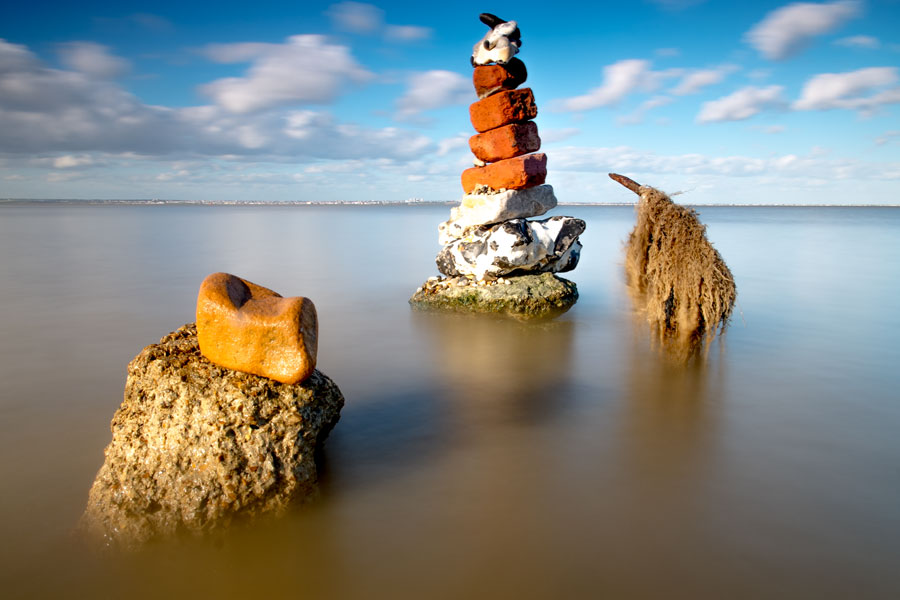Running from 27 June to 30 August, Kashya Hildebrand is pleased to announce Ephemeral Realities and Temporal Landscapes, a solo show of photographs by Richard Pigott in the gallery’s project space.
Like sea creatures emerging from the mist, twisted rods of metal and stone rise up from a milky sea. The sky, at times piercingly blue, at others, bruised with heavy clouds, gives an otherworldly feeling, an alien landscape in which time is at once still and yet speeding relentlessly by. These images – taken in the waters of the Thames Estuary on the Isle of Grain in Kent – are painstakingly assembled by sculptor and photographer Richard Pigott. An environmentalist and former member of Greenpeace, he uses found objects washed upon the shore to create temporary sculptures that evoke a powerful commentary on the excesses of a consumption-oriented society and its relationship with nature. In his juxtaposition of man-made refuse with environmental materials, he creates a fleeting, symbiotic harmony. The backdrop of the Isle of Grain adds a further important layer, as the location of much human intervention. While it provides a major habitat for wetland birds, its surface is scarred with the remnants of human intervention, from early settlements to Second World War bunkers. Today, it is proposed as one of the possible sites of Boris Johnson’s Thames Estuary Airport.
Richard sources hunks of concrete, bricks of varying shades, metal rods, plastic, tarmac and marine detritus such as rusted anchors. These are stacked alongside natural resources such as flint, seaweed and stone. While they reflect man’s global footprint, they also reflect the cohesion and co-existence found in nature, as rough concrete edges are eroded down and smoothed by the force of the waves, the glistening concave and convex edges of flint harking to their own architectural heritage as ancient building blocks – the manmade becoming one with nature, and the natural used in the manmade.
It is a sense of ephemerality, the very temporal nature of his creations, which is at the heart of Richard’s photographs. Using a slow shutter speed allows him to both imbue the surrounding water with a sense of stillness, by smoothing out the ripples and waves, as well as create a feeling of the passing of time. For Richard, they evoke the desert landscapes of Salvador Dali, which act as a canvas for his surrealistic ideas and images. It is this effect he seeks to convey through the smooth appearance of the water, rather like a neutral gallery floor against which the sculpture can be presented in stark contrast with no interference.
Like the works of Andy Goldsworthy, ultimately, each sculpture, no matter how painstakingly assembled, will fall apart, dissolving back into the ocean, and thereby returning to nature. Yet the temporary nature of the works does not bother Richard, rather, the pressure of time and the elements, the movement of the tide, sun and clouds all offer endless inspiration, allowing him the freedom to experiment and improvise in a way unimaginable within the confines of an indoor space or studio. It is only when the piece begins to crumble and fall apart back into the ocean that Pigott believes the piece to truly be ‘complete’.
At times, Richard’s creations resemble strange creatures, at others, they are ethereal many-tiered temples or pagodas. What binds them together is an intensely spiritual experience, an understanding of the relentless cycle of both man and nature, and the border where the two blur together as his sculptures stand, like silent sentinels staring out to sea, until they surrender to the ocean around them, where, below the waves, all elements become one.
PRESS RELEASE: PDF
IMAGE SHEET: PDF
PRESS:
|
|
About Richard Pigott
Currently living and working in Kent, Richard Pigott received his BA Hons in Performance Art and Sculpture from St Martin’s School of Art, London, UK (1977), before pursuing his MFA in Performance Art and Sculpture at the University of Massachusetts, Boston, USA (1982). Recent solo exhibitions include Photographs of North-West Kent and Kuwait, What If Gallery, Dartford, Kent, UK (2011) and Digital Art & Photography, Geoffrey Whitworth Theatre, Crayford, Kent, UK (2009). Prior to this, Pigott spent time in Kuwait, with earlier work including assisting sculptors such as Zadok Ben David and Richard Fleischner.
About Kashya Hildebrand
The gallery's artists challenge pre-conceived notions of nationality and cultural identity, creating an environment in which established norms become blurred and characterizations from seemingly contrasting cultures occupy the same visual space. This juxtaposition leads to a simultaneous renunciation and acceptance of the traditional and the contemporary, creating an environment that is in constant flux. Religion, politics, nationality and culture are treated as the foundation of identity, depicted and disseminated to varying degrees. Through painting, collage, sculpture, photography and installation work the artists convey the contestations of the contemporary political landscape.
Exhibition:
Richard Pigott: Ephemeral Realities and Temporal Landscapes
Location:
Kashya Hildebrand, 22 Eastcastle Street London W1W 8DE, UK Telephone: +44 (0)20 3588 1195
Dates:
27 June - 30 August, 2014 at Kashya Hildebrand Gallery, London, UK
Private Preview in the presence of the artist: Thursday, 26 June 2014 — 6-9 pm
Hours:
Monday – Friday 11am – 6pm, Saturday 12 – 6 pm
Admission is free
For press information and images, please contact:
Anna Wallace-Thompson
+44 (0)20 3588 1195
anna@kashyahildebrand.org
|

